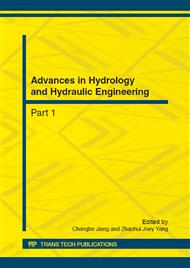p.423
p.430
p.436
p.441
p.446
p.453
p.457
p.461
p.466
A Simple and Effective Prediction Model of Saline Intrusion in the Modaomen Estuary, the Pearl River Delta, China
Abstract:
Saline intrusion is important for ecological reasons as well as water extraction purposes in estuaries. The distance of saline intrusion depends on a number of factors, including river discharge, tidal and wind mixing and gravitational circulation. In this paper, a simple and effective prediction model is derived for the saline intrusion at high slack water in a well mixed, funnel-shaped estuary whose cross-sectional area decreases exponentially (with convergence length a) with distance, x, inland. The model study shows that a graph of salinity against exp (x/a-1) is a straight line, with the slope proportional to the mixing coefficient Dx. The prediction model is presented and validated in Modaomen estuary, one of estuaries of Pearl River Delta in south China and the model results are compared, with good agreement, to the measured data. By analyzing the relationship between the salt intrusion length and tidal range, it is concluded that the optimal time of increasing runoff discharge to prevent saline intrusion is 2 to 3 days before neap tide.
Info:
Periodical:
Pages:
446-452
Citation:
Online since:
October 2012
Authors:
Keywords:
Price:
Сopyright:
© 2012 Trans Tech Publications Ltd. All Rights Reserved
Share:
Citation:


